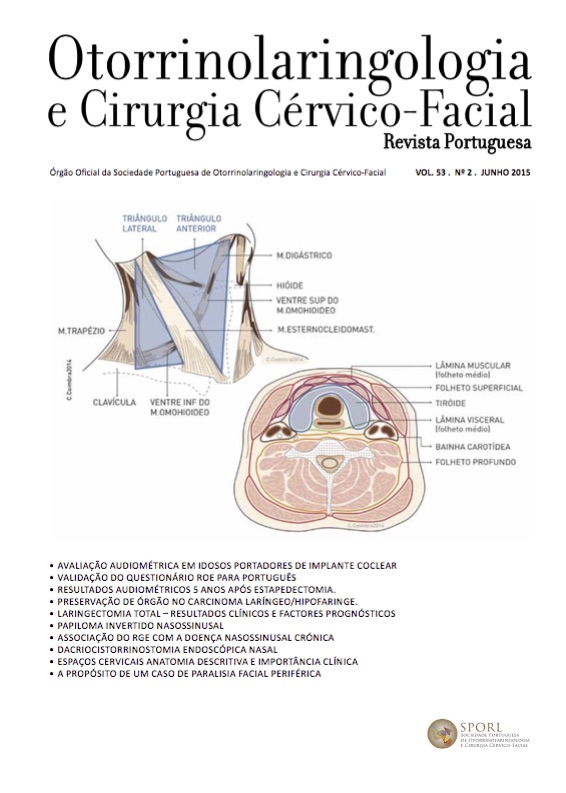Audiometric thresholds and speech perception evaluation in elderly patients wearing cochlear implants
DOI:
https://doi.org/10.34631/sporl.579Keywords:
cochlear implants, elderly, audiometric thresholdsAbstract
Objective: To compare the mean audiometric thresholds and the results of the speech perception test (SPT), between two groups with bilateral post-lingual severe to profound sensorineural hearing loss.
Material and Methods: A retrospective and analytical study, which compared the audiometric thresholds of 50 patients (under 60 and above 60 years old) implanted between May / 2002 and February / 2007.
Results: First group included 42 patients with a mean age of 44.6 years. The audiometric average threshold value was 26.98 dB, and the average value of the SPT was 88%.The second group included 8 patients, with a mean age of 66.7 years. This group had a mean audiometric threshold of 27.26 dB and the average value of SPT was 76.25%. No differences were observed between the audiometric threshold and the SPT of the two groups (p> 0.05).
Conclusion: The average audiometric thresholds and SPT are no different when comparing both groups.
Downloads
References
Bevilaqua MC, Costa OAF, Moret ALM, Amantini RBC. Implante coclear em crianças. In: Campos CAH, Costa HO (Eds.) Tratado de Otorrinolaringologia SBORL, São Paulo, Editora Roca; 2002:pp268-75.
Bevilaqua MC, Costa OAF, Moret ALM, Amantini RBC. Implante coclear em adultos. In: Campos CAH, Costa HO (Eds.) Tratado de Otorrinolaringologia SBORL, São Paulo, Editora Roca; 2002:pp276-89.
Porto PRC. Avaliação de resultados de implante coclear em pacientes deficientes auditivos, secundário à meningite. Dissertação de mestrado à pós-graduação na Faculdade de Ciências Médicas da Universidade Estadual de Campinas em Ciências Médicas na área de Otorrinolaringologia. 2002.
Mangabeira Albenaz PL. Implantes cocleares. Parte I. RBM–ORL. 1995;2(6):119-22.
Luxford W, Brackmann D. The history of cochlear implants. The Surgeon´s workshop Handouts, Cochlear Corporation. 1994.
Summerfield AQ, Barton GR, Toner J, McAnallen C et al. Selfreported benefits from successive bilateral cochlear implantation in post-lingually deafened adults: randomised controlled trial. Int J Audiol. 2006;45 Suppl 1:S99-107.
Mo B, Lindbaek M, Harris S. Cochlear implants and quality of life: a prospective study. Ear Hear. 2005;26(2):186-94.
Chatelin V, Kim EJ, Driscoll C, Larky J et al. Cochlear implant outcomes in the elderly. Otol Neurotol. 2004;25(3):298-301.
Pasanisi E, Bacciu A, Vincenti V, Guida M et al. Speech recognition in elderly cochlear implant recipients. Clin Otolaringol 2003;28:154-7.
Indicadores e Dados Básicos, Brasil – 2012 / IDB – 2012. Ministério da Saúde. Disponível em http://tabnet.datasus.gov.br/cgi/idb2012/matriz.htm#demog (consultado em 25/06/2105).
Carvalho A. I Semana Nacional de Prevenção da Surdez. Prevenir é Ouvir. Int Arch Otorhinolaryngol. 1997;1(3):1.
Bilton T, Ramos LR, Ebel S, Teixeira LS et al. Prevalência da deficiência auditiva em uma população idosa. Mundo Saúde. 1997;21(4):218-25.
Rozenfeld S. Reações adversas aos medicamentos em idosos: as quedas em mulheres como iatrogenia farmacoterapêutica [Dissertação]. Rio de Janeiro (RJ): Universidade do Estado do Rio de Janeiro; 1997.
Viude A. Fatores associados à presbiacusia em idosos. [Dissertação]. São Paulo (SP): Universidade de São Paulo; 2002.
O estatuto do idoso. Certificados digitais, Serasa. Titulo I artigo 1º, 2004.
Orabi AA, Mawman D, Al-Zoubi F, Saeed SR et al. Cochlear implant outcomes and quality of life in the elderly: Manchester experience over 13 years. Clin Otolaryngol. 2006;31(2):116-22.
Vermeire K, Brokx JP, Wuyts FL, Cochet E et al. Quality-of-life benefit from cochlear implantation in the elderly. Otol Neurotol. 2005;26(2):188-95.
Carvalho GM, Guimarães AC, Macedo ISC, Onuki LCB et al. Digisonic SP® Binaural cochlear implant: the coronal tunneled approach. Braz J Otorhinolaryngol. 2013;79(3):298-305.
Tefili D, Barrault GFG, Ferreira AA, Cordioli JA et al. Implantes cocleares: aspectos tecnológicos e papel socioeconomico. Braz J Biom Eng. 2013;29(4):414-33.
Mosnier I, Bebear JP, Marx M, Fraysse B et al. Improvement of Cognitive Function After Cochlear Implantation in Elderly Patients. JAMA Otolaryngol Head Neck Surg. 2015;141(5):442-50.
Lin FR, Chien WW, Li L, Clarrett DM, Niparko JK, Francis HW. Cochlear Implantation in Older Adults. Medicine. 2012;91(5):229-41.






